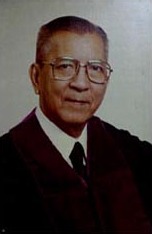Enrique Fernando facts for kids
Quick facts for kids
Enrique M. Fernando
|
|
|---|---|
 |
|
| 13th Chief Justice of the Philippines | |
| In office July 2, 1979 – July 24, 1985 |
|
| Appointed by | Ferdinand E. Marcos |
| Preceded by | Fred Ruiz Castro |
| Succeeded by | Felix Makasiar |
| 80th Associate Justice of the Supreme Court of the Philippines | |
| In office June 30, 1967 – July 1, 1979 |
|
| Appointed by | Ferdinand E. Marcos |
| Preceded by | José Maria Paredes |
| Succeeded by | Venicio Escolin |
| Personal details | |
| Born |
Enrique Medina Fernando
July 25, 1915 Malate, Manila, Philippine Islands |
| Died | October 13, 2004 (aged 89) Manila, Philippines |
| Spouse | Emma Quisumbing-Fernando |
Enrique Medina Fernando (July 25, 1915 – October 13, 2004) was the 13th Chief Justice of the Supreme Court of the Philippines. A noted constitutionalist and law professor, he served in the Supreme Court for 18 years, including 6 years as Chief Justice.
Early career
Fernando was born in Malate, Manila. He obtained his Bachelor of Laws degree at the University of the Philippines College of Law, graduating magna cum laude in 1938. He was a member of the Upsilon Sigma Phi fraternity.
Shortly after admission to the bar, he joined the faculty of his alma mater, where he taught as a full-time member of the faculty until 1953, and as a professorial lecturer for decades afterwards. He was eventually appointed as the George A. Malcolm Professor of Constitutional Law. Later, he would also teach constitutional law at the Lyceum of the Philippines. Fernando was feared for his rather tyrannical manner in the classroom, yet many of his law students would emerge as Supreme Court justices or prominent practitioners in their own right.
In 1947, he was admitted by the Yale Law School as the first Filipino Sterling Fellow, earning his Master of Law degree the following year.
Fernando was appointed as a Code Commissioner in 1953 and served in that capacity until 1964. In the 1950s, he served as a Presidential adviser to Presidents Ramon Magsaysay and Carlos P. Garcia. He likewise engaged in an extensive private practice prior to his appointment to the Supreme Court. Among his law partners was Senator Lorenzo Tañada, with whom he would co-author a popular hornbook on constitutional law. In his lifetime, Fernando would author several books on constitutional and administrative law.
Supreme Court years
In 1966, Fernando was appointed as Presidential Legal Counsel by Ferdinand Marcos. The following year, Marcos appointed him to be Associate Justice of the Supreme Court.
If not for the death of Chief Justice Fred Ruiz Castro in 1979, Fernando would have had the opportunity to become the Chief Justice only in 1984, after Castro reached the mandatory retirement age of 70, and serving for only 1 year until his own retirement. However, Castro died suddenly of a heart attack on April 19, 1979, and Fernando, by then the most senior of the Associate Justices, was promoted by Marcos as Chief Justice.
Jurisprudence
At the time of his appointment to the Court, Fernando was already recognized as one of the country's leading authorities on constitutional law, and as an ardent civil libertarian and active member of the Civil Liberties Union founded by his colleague on the Court, J.B.L. Reyes. He was especially noted for his mastery of American jurisprudence on republicanism and individual rights. He would have ample opportunity to expound on these subjects during his 17-year tenure on the Court.
In Morfe v. Mutuc, 130 Phil. 415 (1968), Fernando wrote for the Court that an anti-graft law requiring the periodic submission by public officials of their statements of assets and liabilities did not infringe on the officer's right to liberty under the due process clause, or on the right to privacy. Nonetheless, Morfe marked the first time the Philippine Supreme Court recognized the existence of a constitutional right to privacy as "accorded recognition independently of its identification with liberty; in itself, it is fully deserving of constitutional protection." The then-recent United States Supreme Court ruling in Griswold v. Connecticut, 381 U.S. 479 (1965) was favorably cited.
Fernando was also a persistent proponent of the clear and present danger test as the only acceptable limitation on the right to free expression, as expressed in his ponencia in Gonzales v. COMELEC, 137 Phil. 471 (1969), and his dissent in Badoy v. Ferrer, 35 SCRA 285 (1970).
Later years
Fernando's lengthy service in the Court ended in 1985, when he reached the compulsory retirement age of 70. Marcos would be toppled from power the following year, and Fernando's most prominent rival Teehankee would be named Chief Justice by Corazon Aquino.
Fernando remained in active practice until shortly before his death at the age 89 in 2004. His expertise as amicus curiae was sought by the Court in the controversial case of Manila Prince Hotel v. GSIS, 267 SCRA 408 (1997).
Fernando is buried at the Libingan ng mga Bayani.

